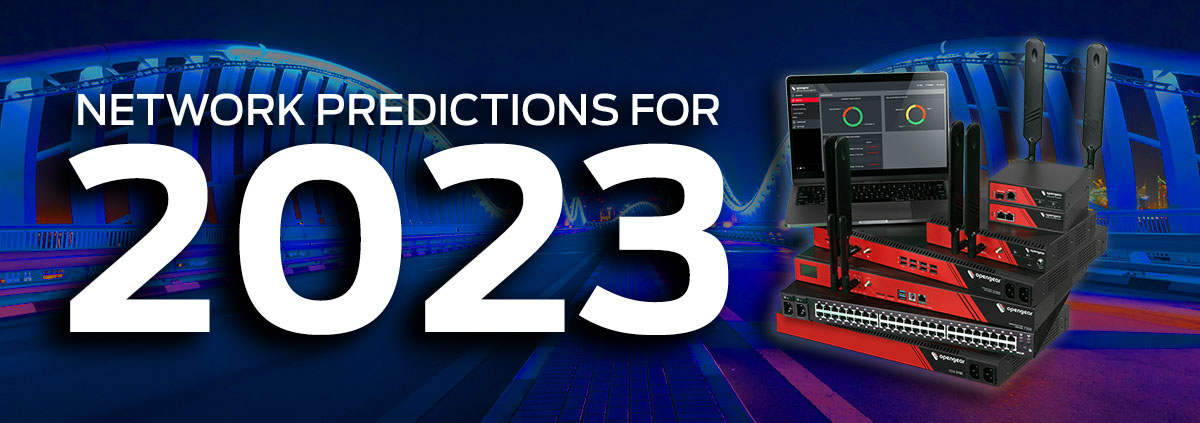
As we kick off 2023, enterprise networking continues to evolve. To remain competitive, exceed customer demands and meet evolving organizational goals, businesses are leveraging the latest technologies. Here’s a look at some trends to keep an eye out for in the new year.
Automation
According to a recent Opengear survey, more than 85% of network engineers have increased their investment in automation over the past two years. What really is automation though? It’s a sweeping term that deals with containerization, orchestration, the works. For many teams, they don’t choose automation, automation chooses them. It’s no longer a nice to have, it’s a necessity, specifically for organizations expanding their edge computing strategies and dealing with latency, large volumes of data and growing network requirements.
“The majority of enterprise networks aren’t prepared to fully embrace all the advanced capabilities of automation yet. As the complexity of these environments grow, million dollar mistakes can happen. This has made it even more critical to have resilient, reliable access to infrastructure, for when a network event does occur. Organizations need to be able to get back online quickly with secure, remote access to their connected resources. They need the ability to be there, without actually having to be.”
~ Daniel Cecalacean, Senior Product Manager, Software
Enabling secure, reliable deployments on Day One, configuration changes and verifying proper network operations are just a few capabilities network engineers will be able to utilize automation for. However, the increased complexity of these highly distributed environments has made integrating automation into daily network operations imperative.
Take the edge for example, all that information needs to be collected, processed and analyzed. To do this in a realistic, reasonable amount of time, network engineers can’t complete this manually. That’s where adaptive Automated Intelligence (AI) and Machine Learning (ML) come in – surprisingly though, only 12% of organizations are using network automation tools for to complete these daily tasks, we call these, the AI achievers.[1] To operate modern networks efficiently, organizations need to leverage AIOps and automation, a trend we’ve been seeing for a while now. Infrastructure needs to be ready for automation because engineers need visibility, confidence and the ability to intervene, correct, or restore when something doesn’t go as planned.
The Cloud
The cloud’s nothing new, for the past two decades it’s been proclaimed as the technology to watch and rightfully so. This year alone, public cloud spending is projected to reach $600 billion.[2] It’s helping power the hybrid workforce, support sustainability goals and make AI goals more accessible. It’s scalable and flexible but there’s a catch, it still requires hardware.
Essentially, the cloud is just another data center, a massive one, with racks, hardware and virtualization, so there’s still challenges when it comes to managing infrastructure. So even way up in the cloud, network engineers still need remote access. Yes, the cloud is secure with firewalls and open VPN connections, but everything is still vulnerable, especially with the amount of people trying to access it. Organizations with a secure remote management solution have always-on access because they can remote in over cellular without having to go on-site.
5G
Organizations will continue to roll out the latest generation of WiFi. However, with more spectrum available and more providers offering services there will be an increase in private 5G deployments. Deployed correctly, it has the potential to provide significant business benefits.
For organizations relying on connected operations, essentially everyone out there, it enables applications that need high throughput and low latency. All of this leads to more reliability and efficiency when it comes data collection and analysis which in turn, helps improve the decision-making process. In most cases, 5G deployments require a significant network redesign and investment. This opens up opportunities to add efficiencies and enable cost savings through optimizations. Network engineers can do more, with less.
Digital Twin
Driving operational efficiency is usually a core goal for digital transformation initiatives and digital twins will be a key strategy in doing this. Since most organizations have multi-vendor networks, it can be challenging to manage – while designing, testing and provisioning updates depends on a manual, usually error prone process. Digital twin technology helps to provide visibility to observe an environment, allowing network operations teams to have an identical virtual network, replicating the organizations. It’s proxy of current state of the environment it’s representing.
Investing in digital twin technology can help improve visibility, enable automation and plan for changes. Helping to convey potential vulnerabilities, highlight inventory and show software version management, it’s extremely feasible to do in comparison to traditional lab network testing where engineers are actually recreating a network, keeping it updated in a lab and running tests. Providing comprehensive visibility, it allows organizations transition from manual to automation based.
Future-thinking network teams are constantly looking to deploy new strategies and for those, a digital twin highlights system complexities, providing situational awareness – but they’re not a complete answer to network management.
Network Resilience In The New Year
However, just one challenge of deploying these digital initiatives is the complexity of many existing enterprise networks – this is where resilience is key. IT infrastructure is the backbone of an enterprise, ensuring operational efficiency. Opengear’s comprehensive platform adds a layer of intelligence to your infrastructure, ensuring the highest levels of business continuity through secure, independent management of connected resources.
You may be thinking, “….but I have redundancy built-in to my operations.” Well, that’s just a piece of the solution needed for maximum uptime. Data center reliability does rely heavily on back-up generators, on-hand replacement hardware and secondary network connections, but what about edge locations?
“The traditional networking engineering culture is dramatically changing due to things like automation, cloud migration and AI. We’ll continue to see that push away from the ‘manual processes’ of traditional network engineering. Vendors and integrators are offering more and more applications and services to enable organizations the ability to purchase or subscribe to automation as a service. Organizations can buy ‘easy buttons’ to automate rather than growing their own. This isn’t new, but the adoption rate is blowing up. ”
~ Matthew Witmer, Senior Principal Engineer, Solutions Engineering
The Network Resilience Platform provides presence and proximity to your connected resources. Leveraging Smart Out of Band, Failover to Cellular and automation, network engineers have secure, remote access to their connected resources via a separate management plane. We’re there for you on the First Day, Worst Day and Every Day.
- First Day: Get your network up and running securely from anywhere
- Worst Day: Got an outage? Not a problem. Have the backup connectivity necessary so that critical processes continue to operate
- Every Day: automate changes to your network, update firmware
Start the new year off right by ensuring network resilience for your organization. Learn how now.
[1] https://www.business-standard.com/article/technology/only-12-companies-are-utilising-ai-to-outpace-their-rivals-report-122061400475_1.html
[2] https://www.fiercetelecom.com/cloud/gartner


